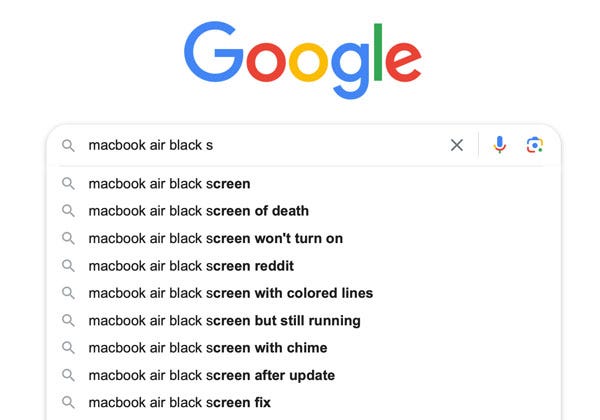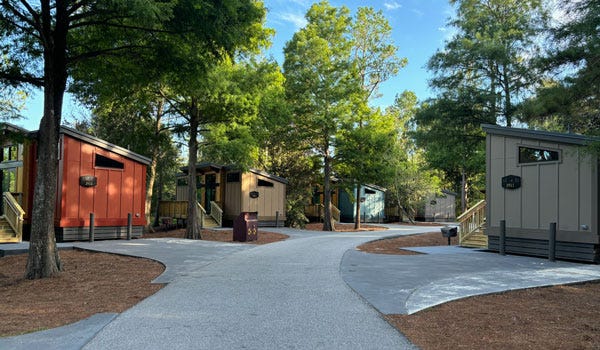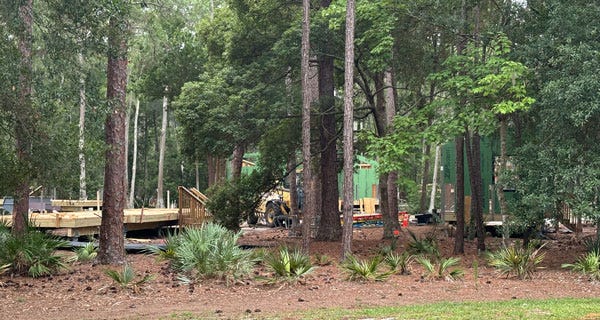Welcome to Willoughby Hills!
Every Wednesday, I offer a few short ideas that I hope will inspire you to do some more reading, thinking, and exploring. Let’s take a little walk together and see where the path leads…
The Black Screen of Death
Don’t freak out! It is Thursday, not Wednesday.
I am a bit delayed in publishing my Wednesday Walk this week for two reasons. The first is personal, which I’ll get to in a minute. But the second is technological.
I purchased a MacBook Air four years ago in the early days of COVID. It has served me incredibly well: I used it to launch my podcast four years ago and have edited every episode of the show on it. It’s where I publish my newsletter. And it’s how I access the rest of the world beyond my front door, from writing emails to paying bills.
Earlier this week, my MacBook decided to just go dark for no reason. Closing and reopening the lid seemed to help for a while, but then I would get a black screen again. This has been consistently happening now for a few days. Sometimes I can work for an hour with no issues, sometimes I can only get a few seconds in before the screen turns dark.
Now yes, I do have a fully functional iPhone and an iPad. But I’m also one of those “elder Millennials” who can’t quite work right if I’m not working on a laptop. So I’m eager to solve this problem.
My attempts at Googling solutions have led to more anxiety than anything, as “black screen of death” seems to be one of the top results. And that doesn’t sound good.
I found a few software solutions and tried them out: updating the operating system, resetting the SMC, and resetting the NVRAM or PRAM. I have no idea what any of those acronyms mean or what they actually do, but the nice person in the YouTube video I was watching seemed to think they would help and the comments section was full of people who agreed.
None of those options worked, which leads me to believe it’s a hardware issue.
There are replacement displays available for under $200, although it sounds like the nicer ones are more than $400, and either option involves me trying to DIY a repair. I read reports that Apple can replace the screen through the Apple Store, but it’s a $600 repair from some reports. This laptop is four years old and cost $999 when brand new. To replace it with a similar model with better specs is still only $999, and Costco has sales on laptops now that would make an upgraded MacBook Pro only a few hundred dollars more.
This gets back to an issue that I’ve discussed many, many times on these pages before. Our products are simply too disposable right now. It’s also something that I discussed last year on the podcast with Sandra Goldmark, so it’s been on my mind a lot.
Apple makes repair of its products difficult and expensive. I’m not sure what percentage of folks would have even explored the various software and hardware repair options I considered, but I suspect a large portion would simply throw in the towel and buy a new laptop at the first sign of a problem.
I will likely end up doing that too at some point, but it’s so disappointing that I feel like it’s my only real option.
I’m not sure how long a laptop should last either. Is four years a reasonable lifespan? Would I feel better if it made it to five, even if that difference is somewhat arbitrary? Should a laptop last eight years?
Apple touts the ease of recycling its products, but as Goldmark had pointed out last summer, taking in old products is useless without incorporating recycled content into new products. Apple has slowly started making gains in this regard, but they still use a lot of virgin material too.
At any rate, as I try to troubleshoot this “black screen of death” and contemplate when and how I want to replace my laptop (or perhaps repair it), my ability to write is a bit hampered. So posts may be a bit more sporadic for a time.
Cabins and ADUs
The other reason for my delay in posting is that I am on a family vacation at the moment.
My wife, kids, and I are spending some time RV camping at Fort Wilderness, the campground located at Walt Disney World in Florida. As many of you know, we bought a used RV towards the end of the height of the pandemic in 2021 after renting one and loving it.
This is our third summer camping in our own RV at this campground, but we have been staying at Fort Wilderness even longer. Prior to owning an RV, we stayed in some of the standalone cabins here, which are quite spacious and well-appointed.
The original cabins, which date to the late 1990s, are in the process of being replaced at the moment. The new ones are colorful and have more windows. The first ones officially open on July 1, with other scheduled to be finished throughout the next few months.
Our RV site happens to face one of the loops where construction is happening, and it’s been fascinating to watch the area go from raw sites where any trace of the old cabins has been cleared to framed cabins to finished cabins in the process of just a few days.
In a post already devoted to waste, it may seem surprising that I’m okay with the replacement of otherwise fine cabins for new ones, but there’s a deeper story here. The old cabins aren’t simply being tossed in a landfill- they are actually being sold, and for a pretty reasonable price.
A local Orlando company recently listed the old cabins for $49,000 on Facebook Marketplace. The cabins come fully furnished with a full kitchen, full bathroom, bedroom, and a living room with a pull out sleeper sofa. The price includes delivery within a 25 mile radius of Orlando, but they’re willing to work out shipping with the buyer as well.
I’m not even kidding when I tell you that my wife and I briefly considered purchasing one of these. Our new yard is nearly an acre and a half, so there would be plenty of space to include a cabin like this.
It sounds like a lark, but there are a lot of practical reasons that we considered this. My mother-in-law used to live five minutes from our old house, but since we moved, she is now more than an hour away. A cabin like this could provide her with her own, autonomous living space, while still being nearby to us.
It could also be used as an “apartment” type space for our kids once they reach adulthood. 45% of people aged 18-29 still live at home, a result of everything from high housing costs to student debt. Having a space where my kids could return yet have their own space feels like a smart investment.
If family didn’t end up living in it, there’s always the possibility of renting it to a tenant or using it for income as an AirBnB or other short term rental.
But before we could even begin exploring this possibility, we looked up the laws for Accessory Dwelling Units (ADUs) in our new town, and they are strictly prohibited unless done as an addition to the current living space and occupied by immediate family.
In other words, we can renovate a basement or attic into an in-law suite or build an addition, but we cannot have a standalone building of any kind on our property that’s used for housing.
It’s not the standalone structure that’s the problem: we have a detached garage and a shed now. We could build a pool house, a “man cave,” a “she shed,” a recording studio, or any other kind of detached structure. Any of those structures can include plumbing, electricity, heating, or cooling. We just can’t have anybody actually live in that space.
ADUs have been a popular topic of conversation in the housing and community development spaces for the last several years. California changed their laws in 2021 to incentivize local communities to build ADUs on existing land. Yet in many parts of the country, ADUs are still strictly forbidden.
Whether it’s a “tiny house” or a recycled Disney cabin, it’s really time that all parts of the country take a closer look at ADUs and other creative housing solutions. Separating single family housing from other multi-family units and apartments was an explicit policy of the federal government during much of the twentieth century. The roots of much of this policy was rooted primarily in racism. (For more on this, listen to my podcast interview with Richard Rothstein).
Housing costs have exploded in many parts of the country. New housing inventory isn’t being built fast enough to house the Americans who need shelter. The ultimate solution is that we need housing of all types everywhere. ADUs are a part of this solution.
As much as a used cabin from Walt Disney World may sound odd, it could be a really good deal for somebody like me. The unit would require shipping to Massachusetts, foundation work, electrical connections, and plumbing connections, but I would bet that all of those costs, including the purchase of the cabin, would be under $200,000.
It’s difficult to find a comparable detached house for that cost in my market, and this would involve reusing something that would otherwise be trashed and that would have a pretty unique backstory.
If we did find a home like that for my mother-in-law (or someday, my kids), it would still require driving to get to our house. Having some kind of ADU in our back yard would eliminate some of those car trips and could allow us to pool resources: cars, groceries, and plenty more.
Sadly, it will never even be a remote possibility for us, as our zoning laws strictly prohibit anything but single family houses in our neighborhood. (If we lived in an area with a Home Owner’s Association, forget about it!)
I think it’s time we acknowledge the true, destructive, racist history of some of these laws and look for ways to address them more progressively and creatively so that we can have affordable housing for all.
I publish new issues every Wednesday and Sunday. Sign up to always receive the latest issue and support my work:
Other Wednesday Walks
The Military Disinformation Complex
If you’ve missed past issues of this newsletter, they are available to read here.










Two very valid reasons and good points made on this Thursday stroll! I upgraded to a MacBook Pro with a 1TB memory because of all the media stuff. Check your specs and get the largest amount of memory you can hold. My Air lasted from 2011-2021!
And ugh on the ADU!